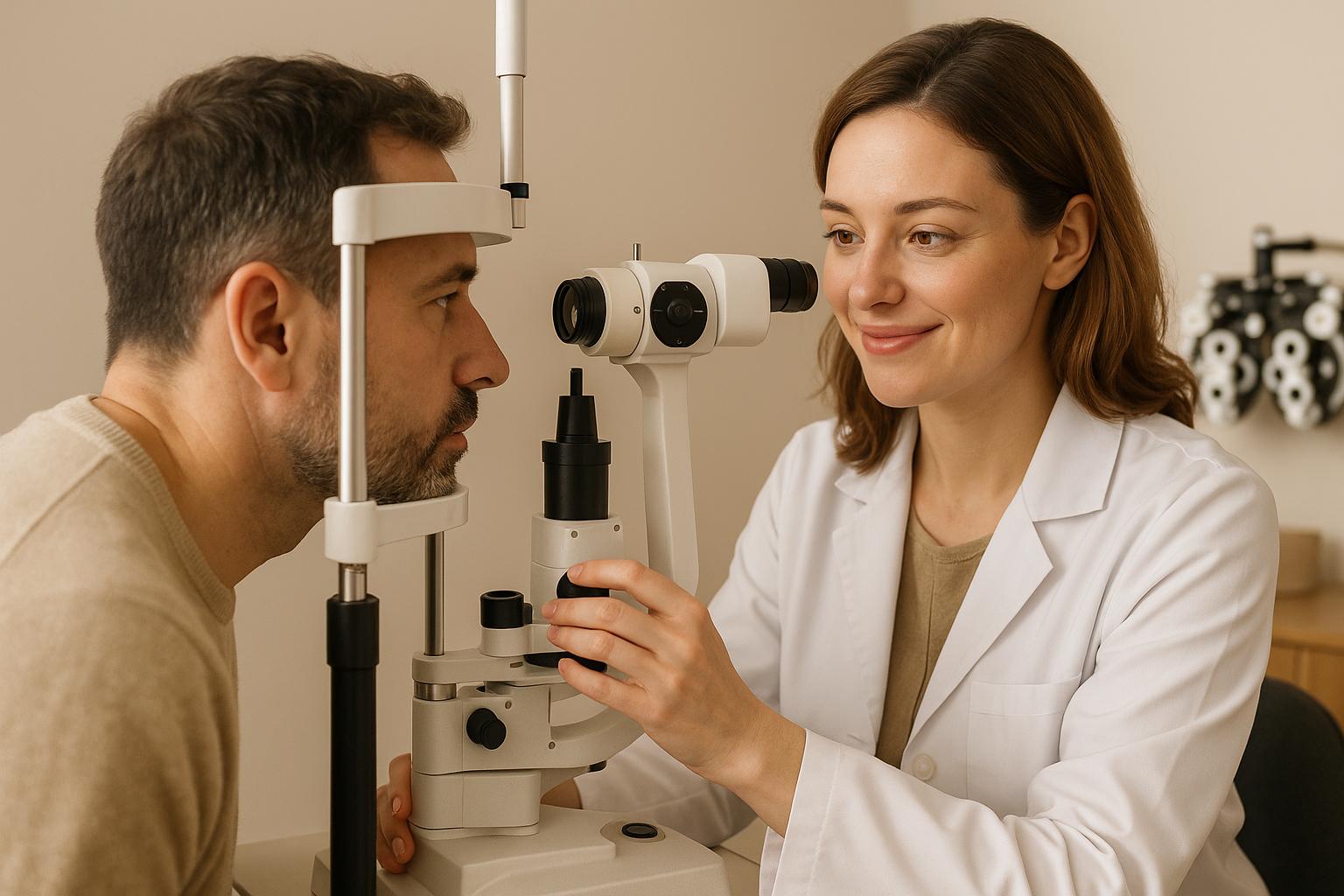When it comes to eye health, the choice is simple: schedule regular eye exams or wait for symptoms to appear. Waiting can lead to irreversible vision damage and costly treatments, while regular exams catch problems early, saving your sight and money.
Key Takeaways:
- Silent Conditions: Diseases like glaucoma and diabetic retinopathy often show no early symptoms.
- Early Detection Matters: Routine exams can identify issues when they’re easier and cheaper to treat.
- More Than Vision: Eye exams can reveal broader health issues like diabetes or high blood pressure.
- Cost Savings: A $200 annual exam is far cheaper than thousands in advanced treatment costs.
Two real-life stories underscore this point:
- Sarah Martinez: Discovered early-stage glaucoma during a routine exam, preserving her vision and uncovering mild hypertension.
- Robert Chen: Delayed care, leading to severe vision loss, costly treatments, and reduced independence.
Bottom Line: Don’t wait for symptoms. Regular eye exams protect your vision, health, and quality of life.
Austin’s Story – A Warning About Online Eye Exams
Patient Story 1: The Benefits of Regular Eye Exams
Let’s talk about Sarah Martinez, a 52-year-old accountant from Fort Collins. For most of her life, Sarah enjoyed perfect vision and never saw the need for an eye exam. That changed when her doctor suggested she start scheduling annual screenings after turning 50.
In March 2024, Sarah decided to book her first comprehensive eye exam at the Eye Center of Northern Colorado. She expected a routine check-up to confirm her healthy eyesight. What she didn’t expect was for her optometrist to uncover a hidden issue.
Early Detection of Eye Conditions
During the exam, Sarah’s optometrist conducted a series of standard tests – checking her visual acuity, eye pressure, and retinal health. These tests revealed two concerning findings: elevated intraocular pressure and subtle changes in her optic nerve.
"I had no symptoms whatsoever – no pain, no vision changes, nothing. I felt perfectly fine."
The diagnosis? Early-stage glaucoma. This condition is often called the "silent thief of sight" because it progresses without symptoms, leaving more than half of patients unaware until significant damage has already occurred. Sarah’s case was no different.
Thanks to early detection, Sarah’s optometrist was able to act quickly. She was prescribed daily medicated eye drops and scheduled for quarterly monitoring. This proactive approach prevented further damage and preserved her vision.
Better Quality of Life Through Regular Care
Eighteen months later, Sarah’s glaucoma remains stable. Her optic nerve shows no additional damage, and she hasn’t experienced any vision loss. Early intervention allowed her to begin treatment before her condition could worsen, sparing her from more invasive procedures .
"I can drive at night safely. I continue working on detailed financial reports all day, and I haven’t had to change anything about my daily routine. My doctor says that if we hadn’t caught it when we did, I could have lost significant peripheral vision within a few years."
But the benefits didn’t stop there. Regular eye care also improved Sarah’s overall health. During one of her follow-up appointments, her optometrist noticed changes in her retinal blood vessels. This observation suggested elevated blood pressure, prompting Sarah to visit her primary care physician. That visit led to a diagnosis of mild hypertension. By addressing this early, Sarah not only protected her overall health but also reduced stress on her retinal vessels, further safeguarding her vision.
"The peace of mind is incredible. I know exactly what’s happening with my eyes, and I feel confident that we’re staying ahead of any problems. My friends of the same age have started scheduling their appointments after hearing my story."
According to the American Academy of Ophthalmology, regular eye exams can reduce the risk of blindness by up to 95% when conditions like glaucoma are treated early. Sarah’s story is a powerful reminder of how timely care can turn a potentially life-altering diagnosis into something manageable.
Today, Sarah continues her daily life without interruption. She feels secure about her long-term vision health and is grateful for the proactive care that made all the difference. Her experience is a testament to the importance of regular eye exams and serves as a compelling example of why early detection matters.
Patient Story 2: The Cost of Delaying Eye Care
Let’s meet Robert Chen, a 58-year-old construction supervisor from Greeley. Like many, Robert had a habit of putting off routine health appointments, waiting until symptoms became impossible to ignore – a decision that would later have serious consequences.
For nearly two years, Robert noticed subtle changes in his vision. Colors didn’t seem as bright, and he occasionally bumped into objects on his right side. He chalked it up to long work hours and getting older, brushing off his wife’s repeated suggestions to see an eye doctor. This delay would eventually lead to a crisis that changed his life.
"I thought I was just getting older. My vision seemed fine most of the time, so I figured there was no rush."
By the time Robert finally decided to seek help in September 2024, his vision problems had worsened. Blind spots became more apparent, and seeing in low light turned into a daily struggle. These issues started interfering with his job performance and raised safety concerns on construction sites.
A Late Diagnosis with Serious Implications
When Robert visited the Eye Center of Northern Colorado, a comprehensive exam revealed the severity of his condition. He was diagnosed with advanced glaucoma, marked by 40% peripheral vision loss, intraocular pressure of 32 mmHg, and irreversible optic nerve damage. The situation called for immediate, aggressive treatment. His care plan included three daily medications, laser surgery within two weeks, and the possibility of additional procedures.
The financial burden was steep. In just six months, Robert’s treatment costs soared past $8,500, covering multiple laser surgeries, specialized medications, and frequent follow-ups. Even with 80% insurance coverage, his $1,700 out-of-pocket expenses were a sharp contrast to the $200 he would have spent on a routine annual eye exam.
The CDC emphasizes that comprehensive dilated eye exams are the best way to catch eye diseases early, often preventing vision loss. Robert’s case serves as a stark example of what can happen when preventive care is delayed.
Living with the Consequences
The physical challenges of his condition soon gave way to emotional and practical struggles. Today, Robert lives with permanent vision loss that impacts nearly every aspect of his life. He can no longer drive safely at night and has had to adjust his role at work. Operating construction equipment is no longer an option, forcing him into supervisory tasks with reduced income. These changes have only deepened his regret over not addressing his vision issues sooner.
Emotionally, the toll has been heavy. Frustration and regret weigh on him, knowing much of his vision loss could have been avoided. His decreased independence, coupled with fears of further deterioration, has been a daily challenge.
"I wish I had prioritized my eye exams earlier. The damage could have been prevented. Now I have to live with this for the rest of my life, and it affects everything – my work, my hobbies, even simple things like walking in crowded places."
Robert’s story is not unique. Studies reveal that up to half of those with glaucoma are unaware they have it, often because they skip routine exams.
Now, Robert has become a vocal advocate for regular eye care, urging his colleagues and family members to prioritize their vision health. He’s learned firsthand that many eye diseases progress silently, causing damage long before symptoms appear. His message is clear: waiting for symptoms can lead to life-altering consequences.
"I tell everyone now – don’t wait like I did. Those yearly eye exams seem expensive until you’re facing surgery and permanent vision loss. The peace of mind and early treatment are worth so much more than the cost of prevention."
Robert remains committed to his treatment plan, hopeful that he can preserve the vision he still has. His experience is a powerful reminder of the importance of preventive eye care and the risks of waiting too long to act.
sbb-itb-5ef6ec9
Comparing Regular Exams vs. Symptom-Driven Visits
Sarah Martinez and Robert Chen’s experiences highlight an important reality about eye care: timing can drastically change outcomes. When comparing preventive care to reactive care, the differences are striking, with significant implications for vision, finances, and overall well-being.
Regular eye exams improve early detection rates by 60% and lower the chances of severe vision loss by 40% compared to those who only seek care when symptoms appear. Patients diagnosed early often have access to less invasive treatments and better management options. On the other hand, waiting until symptoms develop frequently leads to more aggressive – and less effective – interventions aimed at addressing advanced conditions.
From a financial perspective, preventive care is also more manageable. A comprehensive eye exam typically costs between $100 and $250, while advanced treatments can run into thousands of dollars. The table below outlines the major differences between these approaches.
Comparison Table of Outcomes
| Factor | Regular Eye Exams | Waiting for Symptoms |
|---|---|---|
| Early Detection Rate | 60% higher likelihood of early diagnosis | Often results in late-stage detection |
| Risk of Severe Vision Loss | 40% lower risk of impairment | Higher risk due to delayed treatment |
| Treatment Options | More choices with less invasive procedures | Limited options, often requiring surgery |
| Cost Over Time | $100–$250 annually for prevention | Thousands in advanced treatment costs |
| Quality of Life Impact | Maintained independence and function | Potential job limitations and driving restrictions |
| Systemic Disease Detection | Early identification of diabetes and hypertension | Missed opportunities for early intervention |
These comparisons make a strong case for proactive eye care. Regular exams not only help preserve vision but also play a crucial role in detecting systemic conditions like diabetes, high blood pressure, and neurological issues – often before other symptoms arise.
Studies like the Manhattan Vision Screening and Follow-Up Study have shown the effectiveness of community-based optometric exams in identifying vision-related conditions in adults over 40. Participants in these programs reported high satisfaction and were more likely to follow through with additional care when they received adequate support.
Additionally, a 2023 Vision Council study found that routine eye exams reduced the need for surgical interventions in managing diabetic retinopathy by 30%. The CDC also emphasizes that comprehensive dilated eye exams are the most reliable way to detect eye diseases early, often preventing vision loss altogether.
This proactive approach not only safeguards sight but also helps maintain independence and quality of life, which can be severely impacted by advanced eye diseases. The evidence is clear: regular eye exams deliver better outcomes across every measure, from health and treatment options to financial costs and overall life quality.
Key Lessons: Why Regular Eye Exams Matter
Stories from patients and hard data show one thing clearly: taking charge of your eye health early is far better than waiting for symptoms to appear. Regular eye exams can catch problems before they escalate, protect your vision, and save you from expensive and complicated treatments. The reality is that many eye conditions remain hidden until significant damage has already occurred.
Take glaucoma, for instance – almost 50% of cases go undiagnosed. And with diabetic retinopathy, early detection can prevent up to 80% of vision loss. The problem is, by the time you notice symptoms like blurry vision or discomfort, the damage might already be irreversible.
But there’s more to eye exams than just spotting eye conditions. These checkups can also uncover early signs of broader health problems, contributing to your overall well-being.
From a financial perspective, routine exams are far more affordable than addressing advanced eye diseases. Prevention is not only cost-effective but also often the only way to avoid permanent vision loss.
Beyond the financial and medical benefits, regular eye care can enhance your quality of life. Being able to drive safely, enjoy hobbies, and stay independent becomes increasingly important as age-related eye conditions become more common. These insights underline the importance of taking proactive steps to protect your vision.
Practical Steps for Prioritizing Eye Health
Based on real patient experiences, here’s how you can take charge of your eye health:
- Schedule regular eye exams. Make it a habit to book a comprehensive eye exam every year. If you have risk factors like diabetes or a family history of eye disease, you may need to go more often. Setting reminders on your calendar can help you stick to this routine.
- Don’t wait for symptoms. Blurry vision, headaches, or eye pain often signal advanced issues that could have been managed earlier. Keep in mind, clear vision doesn’t always mean healthy eyes, as many serious conditions develop silently.
- Choose a provider with advanced care options. Clinics like the Eye Center of Northern Colorado offer full-service care, including fellowship-trained specialists and state-of-the-art diagnostics. Having a trusted provider ensures you’ll receive consistent care as your needs change.
- Update your prescription regularly. Even minor adjustments to your vision prescription can make a big difference, especially with the rise of digital eye strain caused by extended screen use. Staying up-to-date can improve your comfort and reduce strain.
- Learn your personal risk factors. If you have diabetes, controlling your blood sugar and keeping up with eye exams is crucial. If eye conditions run in your family, discuss this with your provider to establish the right screening schedule.
Taking these steps today can safeguard your vision and maintain your quality of life for years to come. Proactive care isn’t just about your eyes – it’s about living life to the fullest.
FAQs
Why should I get regular eye exams even if my vision seems fine?
Regular eye exams play a crucial role in keeping your eyes healthy, as changes in vision often happen gradually and without obvious signs. Serious conditions like glaucoma or macular degeneration can develop quietly and only become apparent once they’ve advanced.
Scheduling regular check-ups allows for early detection of potential problems, helping to safeguard your vision. Even if your eyes feel fine, preventive care is essential for maintaining their health over the long term.
Can an eye exam reveal health issues like diabetes or high blood pressure?
During a thorough eye exam, your eye doctor might uncover early signs of broader health concerns like diabetes or high blood pressure, sometimes even before you notice any symptoms. This is because the blood vessels in your retina can reveal changes associated with these conditions.
Take diabetes, for instance – it can damage the small blood vessels in your eyes, leading to a condition called diabetic retinopathy. Similarly, high blood pressure can cause noticeable changes in the blood vessels or even affect the optic nerve. Regular eye exams don’t just safeguard your vision – they can also offer important clues about your overall health.
What are the financial risks of waiting to address eye health issues until symptoms appear?
Regular eye care isn’t just about keeping your vision sharp – it can also save you money in the long haul. Waiting until symptoms become noticeable often means dealing with more advanced (and expensive) problems. Preventive eye exams are generally less costly compared to treatments for serious conditions, which might involve pricey procedures, medications, or even surgery. Plus, untreated eye issues can sometimes lead to vision loss, potentially affecting your ability to work and causing indirect costs like lost income or a diminished quality of life.
By making routine eye exams a priority, you can catch potential problems early, often avoiding the need for more expensive interventions down the line. Taking care of your eyes now can reduce financial stress and protect your overall well-being.





